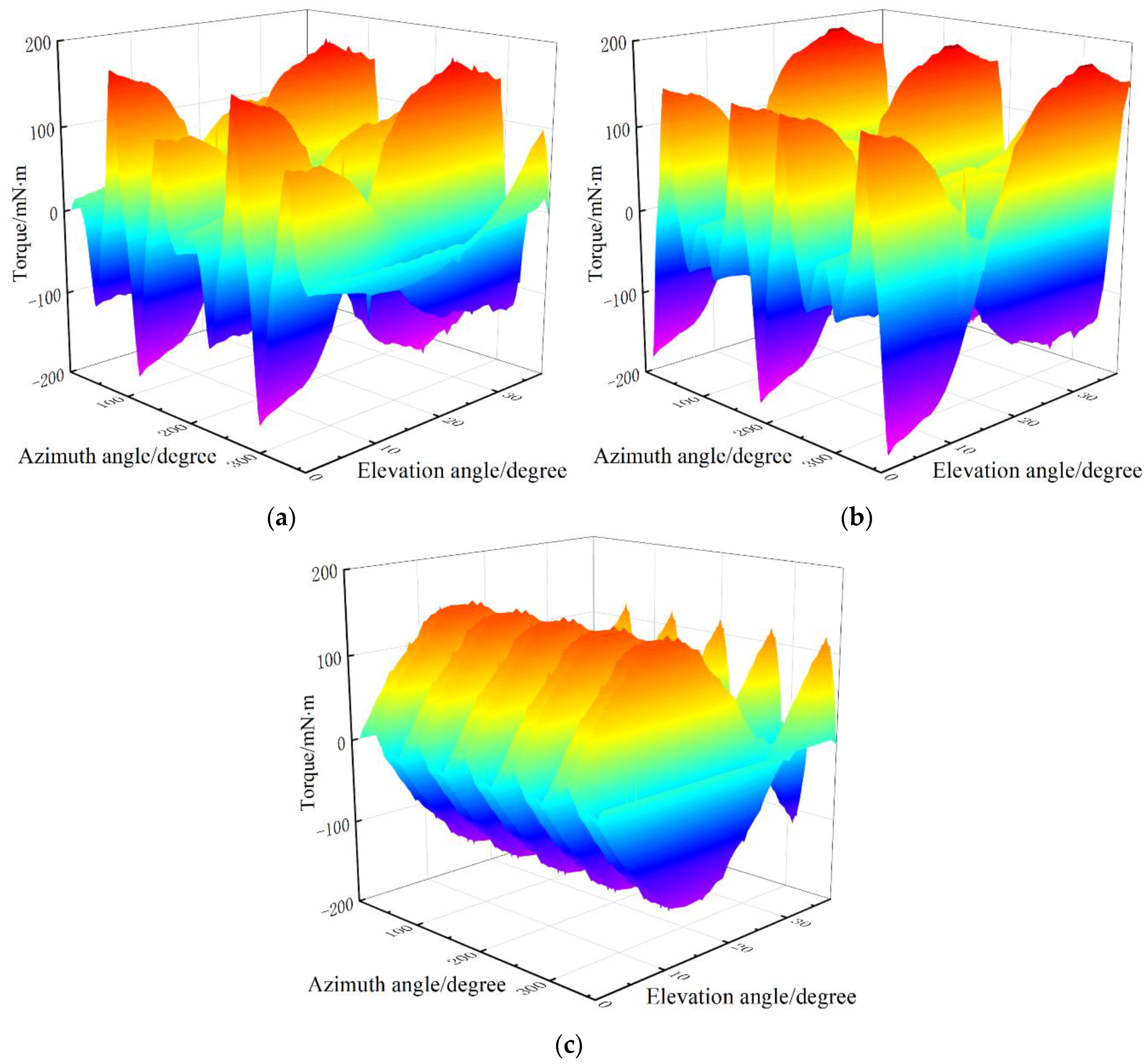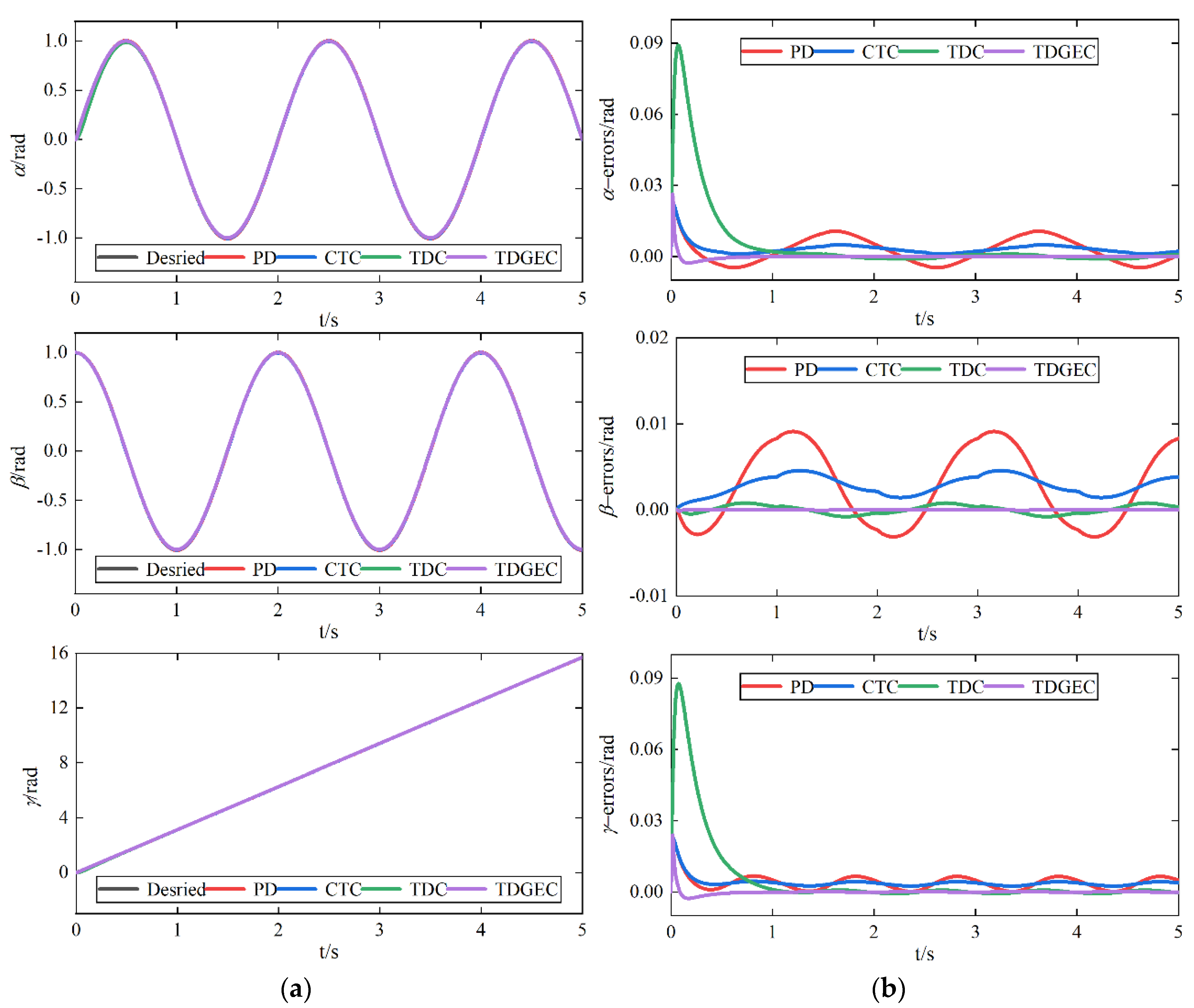1. Introduction
Usually, the multiple dimensional motion on a single axis must be achieved by multiple single-shaft motors and complex mechanical transmission mechanisms. However, this will increase the weight, volume, and design cost of the system, reduce stiffness and dynamic performance, and generate working singularity. By contrast, the novel spherical motor can realize three degree-of-freedom (DOF) of motion at one node. It has broad potential applications in essential fields such as robotics, industrial manufacturing, and precision assembly [
1,
2,
3]. In [
4], the shell-like induction motor was concretized as a traction motor in an electric wheel-chair. In [
5], the concept of a spherical-motor-based motion platform for providing high performance nozzle-substrate negotiation in conformal printing of curved electronics was presented. The spherical motor has become a research focus worldwide.
In the process of research in recent decades, spherical motors with various structures and principles such as induction, permanent magnet (PM), and ultrasonic have been produced [
6,
7,
8]. The spherical motors usually refer to the multi-DOF motors with spherical rotors. As for the permanent magnet spherical motor in [
7], its rotor is composed of two spherical surfaces, on which the PM poles are distributed symmetrically. It is worth noting that the distribution of stator coils and the PM poles are extended into three dimensional space. The magnetic field interacts with the current input in the stator coils and creates torque vectors in the space to move the rotor in 3-DOF.
This paper mainly studies a Permanent Magnet Spherical Actuator (PMSpA) with a compact structure. The control goal of the spherical motor is to make the rotor output shaft reach a continuous trajectory from the initial position to any desired position. For fulfilling such a purpose, scholars have proposed many control algorithms. In [
9,
10], the Proportional Derivative (PD) control method was put forward. The PD controller is simple and easy to design, but it requires a large control torque to compensate for uncertainties and external disturbances and has a certain degree of conservatism. In [
11], a Computational Torque Control (CTC) method was proposed to linearize and decouple the dynamic model. However, this method is a model-based method, and the control accuracy will be affected in the presence of uncertainty, friction, and external disturbances. In addition, scholars have proposed adaptive control [
12,
13], neural network identifier-based control [
14], sliding mode control [
15], decoupling control [
16], and other intelligent control methods, but these controllers have a complicated structure and are cumbersome in the gain adjustment process, which are not convenient for practical applications.
A time delay estimation control method with a simple structure and good robustness was proposed for the tracking problem of robot systems with the unknown dynamic model [
17]. The main idea of this control method is to estimate unknown and difficult nonlinear terms in complex dynamic equations by using the values of delayed input torque and acceleration. The time delay estimation control has been widely used in mechanical systems and control schemes because of its simple control system and relatively simple control gain selection.
However, when the nonlinear disturbances such as friction and external disturbance exist in the system, the performance of time delay estimation control will be degraded. This will result in large estimation errors and affect the control effect [
18]. In [
19], a time delay estimation control method with ideal speed feedback for systems was designed to compensate for the estimation errors. The speed feedback is used to eliminate the nonlinear term that cannot be offset by the time delay estimation control. However, it is difficult for the speed feedback to correct the estimation errors caused by various uncertain disturbances, and the robustness of the system is poor. In [
20,
21,
22], a sliding mode controller is added to the time delay estimation control to reduce estimation errors. However, the implementation of the sliding mode control algorithm needs to know the upper bound of disturbance, and it is easy to cause the chattering of the position tracking response and output torque, which will affect the motor body. In [
23], a method combining time delay estimation control with fuzzy logic was put forward, which uses fuzzy logic to eliminate nonlinear terms, but fuzzy control will make the system complicated and increase the amount of calculation. Although the above methods can effectively suppress the time delay estimation errors, more control gain will make the system complicated, and the control gain adjustment is time-consuming, which will increase the burden of actual controller design.
Considering the nonlinear uncertainty and strong coupling of PMSpA body structure and dynamic model [
24], this paper has proposed the time delay estimation control method based on gradient compensation (TDGEC), which deals with unknown and nonlinear terms in complex dynamic equations through time delay estimation, and at the same time uses gradient compensation to reduce the estimation errors caused by time delay estimation control. The simple structure of the proposed controller can improve the tracking effect of the complex nonlinear PMSpA motion control system and avoid the complicated gain adjustment process. Finally, the PD control method, CTC method, and traditional Time Delay Estimation Control (TDC) are used for simulation and experimental comparison with the proposed controller.
The remainder of this paper is organized as follows. In
Section 2, the structure and dynamic model of the PMSpA are introduced. In
Section 3, a time delay estimation controller with gradient estimation is designed, and the stability of the control system is verified based on the Lyapunov method. The PD controller, CTC controller, and TDC controller are used to simulate and compare with the proposed control algorithm in
Section 4.
Section 5 introduces the experimental platform and carries on verification on the experimental platform. Finally, conclusions are made in
Section 6.
4. Simulations
In order to compare the simulation effect of the proposed controller, this paper designs four comparative control schemes: (1) the PD method; (2) the CTC method; (3) the TDC method; and (4) the proposed TDGEC method. According to
Figure 4, a simulation model of the PMSpA position tracking control system is built in the MATLAB/SIMULINK environment, as shown in
Figure 5. First, the given trajectory
θd is input to the controller. According to the general design steps of the TDC controller, the error dynamics is injected into the TDGEC controller. At the same time, the error dynamics are passed through the gradient compensator to get
, which can reduce the estimation error caused by the TDC. Finally, the actual control torque
u is constructed by combining the output torque of the previous moment to drive the PMSpA for trajectory tracking control.
Under the same expected trajectory and nonlinear disturbance,
Section 4.1 and
Section 4.2 are designed for simulation under different modeling errors and different load torque, respectively.
The simulation parameters are set as follows. The control gains of the PD controller and CTC controller are both
Kp =
diag{30,30,30},
Kd =
diag{5,5,5}. According to the actual size and structural parameters of the PMSpA prototype, the rotational inertia calculated using COMSOL Multiphysics
® is as follows:
To verify that the PMSpA has fully controllable operating conditions, the desired trajectory is set as
The initial position and speed setting of the system are as follows:
The modeling errors are set as:
where
r represents the modeling error coefficient.
The nonlinear disturbance
Fq are set as the following two parts:
The load torque is set as
where
w is the load moment coefficient.
The sampling time L of the system is set to 0.001 s. The gain matrices of the TDC controller are = diag{0.006,0.007,0.008}, Kp = diag{120,120,120}, Kd = diag{30,30,30}, and KGC = diag{100,100,100}.
4.1. Simulation under Different Modeling Errors
In order to verify the influence of the modeling error on the proposed controller, it is assumed that the model has varying degrees of uncertainty. Based on the interference as shown in Equation (24), the load moment coefficient
w and the modeling error coefficient
r are set as 1 and 0.4, respectively, which means that the system has 40% modeling uncertainty. The tracking curves and tracking error curves of the four controllers are shown in
Figure 6a,b, respectively.
It can be observed from
Figure 6a that under the condition of 40% model uncertainty, the trajectory tracking using the TDGEC algorithm fits the desired trajectory well. In addition, the tracking error curves show that the error change of the system using the TDGEC algorithm is more stable. Under 40% modeling error, using four control algorithms, the absolute of the Max Steady-State Error (AMSSE) in three directions is shown in
Table 2. The AMSSE values of using the TDGEC method are 5.02 × 10
−5 rad, 2.82 × 10
−5 rad, and 5.07 × 10
−5 rad, which are much smaller than those of the other three controllers.
Furthermore, select the Root Mean Square Error (RMSE) under the four controllers to evaluate the adaptability and robustness of the controller.
Figure 7 shows the RMSE with the variation of
r from 0.2 to 0.8. The RMSE using the TDGEC controller is the smallest compared with the other three controllers. The results show that the TDGEC control method is not sensitive to the model parameters. In the presence of model uncertainty, the TDGEC controller can obtain better performance and better robustness.
4.2. Simulation under Different Load Torque
In the practical applications, the load will affect the control accuracy to a certain extent. In this section, the four controllers are designed with modeling error coefficient
r = 0.3. The load torque coefficient
w is changed from 1 to 5, which means that the system is under 30% model uncertainty and has to withstand different degrees of load torques. The parameter setting of the four controllers is the same as mentioned above. The tracking curves and tracking error curves when the load torque coefficient
w = 3 are shown in
Figure 8a,b, respectively.
Similarly, the AMSSE values under the four control methods are shown in
Table 3. The expected trajectory is closely tracked using the TDGEC controller, which can be seen in
Figure 8a. In addition, we can see from
Figure 8b that under PD control and CTC control, the steady-state tracking error is very obvious, which means that the load seriously affects the tracking accuracy. In contrast, the tracking error after reaching the steady-state is the smallest with the TDGEC controller, and the AMSSE values are only 4.61 × 10
−5 rad, 2.56 × 10
−5 rad, and 4.71 × 10
−5 rad, respectively.
Figure 9 shows the RMSE when
w varies from 1 to 5. It can be seen that with the change of
w, the RMSE of the TDGEC controller is the smallest among the four control methods. Moreover, the RMSE value has no noticeable change. However, when the load changes with the PD controller and CTC controller, the RMSE value changes obviously, indicating that the robustness of these two controllers is poor. The simulation results demonstrate that the TDGEC controller can maintain a good tracking effect under the influence of the external load torque.
From the above numerical simulation results, we can conclude that the proposed TDGEC controller offers an improved controller design for high-precision motion control of PMSpA with model uncertainty and nonlinear disturbances. Furthermore, the control gain adjustment is simple, which is convenient for the actual controller design.


















